Personal hygiene is important for all of us, particularly in the workplace, and even more so when working within a food handling role. When working in any food handling related role, taking care of your hygiene is an essential part of your job.
By the end of this topic, you will understand:
- Tips for managing your hygiene in a food handling role
- The importance of proper and thorough hand washing
- How to manage illness or injury in a hygienic way.
Note
The relevant Standard for dealing with hygiene in food business is:
Looking after your hygiene and presentation means you must ensure you are clean, tidy and presentable. Some examples of basic things you can do to look after your hygiene and presentation when working in a food handling role include:
- Showering daily
- Using antiperspirant products
- Washing your hands properly and thoroughly at all appropriate times
- Having clean, neat and tidy hair (long hair should be pulled away from your face with a secure hairband)
- Wearing appropriate clothing and protective aids such as:
- Freshly laundered and ironed uniform
- Appropriate closed-toe footwear
- Apron
- Gloves
- Hair net
- Avoid wearing jewellery because both the jewellery, and the skin under the jewellery, can be hard to cleanse properly, and can therefore carry bacteria which may contaminate food
- Avoid wearing nail polish as it may prevent you from seeing whether your nails are properly clean. It may also chip or come away, and may end up in the food you are handling. Short, clean, neat nails are the most hygienic when working with food.
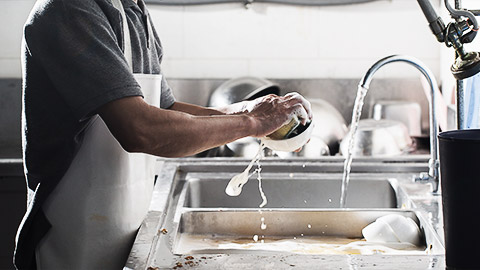
The following information is an excerpt from Safe Food Australia (Division 4 — Health and hygiene requirements, 15 Hygiene of food handlers):
Jewellery
Jewellery can act as a reservoir for food-borne pathogens and may hinder thorough cleaning of hands and wrists. Jewellery or parts of jewellery may also fall into food and cause medical problems for consumers, such as chipped and/or broken teeth and internal cuts and lesions (US Food Code 1999).
Practical measures that food handlers who are in direct contact with exposed food and surfaces likely to come into contact with food can take to prevent jewellery from contaminating food include:
- wearing no jewellery or a minimum amount of jewellery, especially on hands and wrists;
- if any jewellery is worn on hands or wrists, ensuring that extra effort is made to clean under the jewellery, and the hands and wrists are thoroughly dried after washing;
- wearing gloves over jewellery on hands, if hands are to be used in direct contact with food;
- avoiding fiddling with jewellery, especially earrings for pierced ears as bacteria can grow in and around the hole; and
- ensuring jewellery worn is not loose, especially earrings. Hair clips, hair pins, etc. The main risk with hair clips and pins is that they can fall into food and possibly cause injury to a person who attempts to eat food containing the hair clip or pin. Food handlers should ensure that hair clips and hair pins are kept to a minimum and secured if the food handler is working in direct contact with food or surfaces likely to come into contact with food.
The early childhood services have requirements relating to hygienic practices within your workplace. These requirements will be in accordance with the food safety program. You should seek out these procedures and ensure you follow them.
In early childhood services, the chefs will be required to wear appropriate clothing as detailed above. The uniform and protective aids are for your own personal safety as well as the prevention of contamination of food.
The following information is an excerpt from Safe Food Australia (Division 4 — Health and hygiene requirements):
5 Hygiene rules for food handlers
- A food handler must, when engaging in any food handling operation:
- take all practicable measures to ensure his or her body, anything from his or her body, and anything he or she is wearing does not contaminate food or surfaces likely to come into contact with food;
- take all practicable measures to prevent unnecessary contact with ready-to-eat food;
- ensure outer clothing is of a level of cleanliness that is appropriate for the handling of food that is being conducted;
- only use on exposed parts of his or her body bandages and dressings that are completely covered with a waterproof covering;
- not eat over unprotected food or surfaces likely to come into contact with food;
- not sneeze, blow or cough over unprotected food or surfaces likely to come into contact with food;
- not spit, smoke or use tobacco or similar preparations in areas in which food is handled; and
- not urinate or defecate except in a toilet.
- A food handler must wash his or her hands in accordance with subclause
- whenever his or her hands are likely to be a source of contamination of food;
- immediately before working with ready-to-eat food after handling raw food; and
- immediately after using the toilet.
- A food handler must, when engaging in a food handling operation that involves unprotected food or surfaces likely to come into contact with food, wash his or her hands in accordance with subclause
- before commencing or re-commencing handling food;
- immediately after smoking, coughing, sneezing, using a handkerchief or disposable tissue, eating, drinking or using tobacco or similar substances; and
- after touching his or her hair, scalp or a body opening.
- A food handler must, whenever washing his or her hands:
- use the hand washing facilities provided;
- thoroughly clean his or her hands using soap or other effective means, and warm running water; and
- thoroughly dry his or her hands on a single use towel or in another way that is not likely to transfer pathogenic micro-organisms to the hands.
- A food handler who handles food at temporary food premises does not have to clean his or her hands with warm running water, or comply with paragraph (4)(c), if the appropriate enforcement agency has provided the food business operating from the temporary food premises with approval in writing for this purpose.
Read
Read the following information on health and hygiene:
- Food Standards Australian New Zealand information on health and hygiene: “Health and Hygiene – Advice for food handlers”
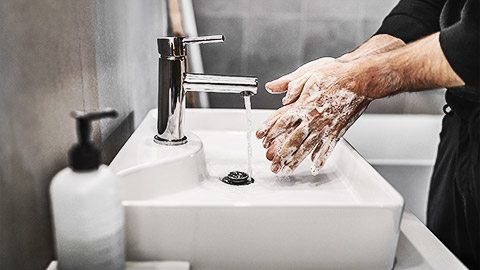
Note
The relevant Standard for dealing with handwashing in food business is:
The importance of handwashing cannot be understated in a food handling role. Workers in food handling roles who do not wash their hands properly may contaminate food and leave those who eat the food susceptible to food-borne illnesses.
It is important to note that even when washing hands, many people do not wash their hands properly or thoroughly enough, and again, this leaves both themselves and others exposed to the risk of illness.
Healthdirect provides the following information on when to wash your hands, and tips on how to wash your hands properly7:
Wash your hands before touching anything that needs to stay clean, and after touching anything that might contaminate your hands!
Examples include:
- when your hands are visibly dirty
- after going to the toilet
- after helping a child go to the toilet, or changing a nappy
- after handling rubbish, household or garden chemicals, or anything that could be contaminated
- before you prepare or eat food
- after touching raw meat
- after blowing your nose or sneezing
- after patting an animal
- after cleaning up blood, vomit or other body fluids
- after cleaning the bathroom
- before and after you visit a sick person in hospital
- before and after touching a wound, cut or rash
- before commencing or recommencing work with food
- immediately after handling raw food
- after smoking
- after coughing
- after sneezing
- before handling foods and drinks
Wash your hands before you prepare or eat food!
It's a message worth repeating — hand washing is by far the best way to keep children and educators from getting sick and prevent the spread of germs.
Please read:
- Hand washing and parents' responsibility - developed by KidsHealth.
How to wash your hands
Protect yourself and others against infections
Wet hands
Apply soap
Rub hands palm to palm
Lather the backs of your hands
Scrub between your fingers
Rub the backs of the fingers of the opposing palm
Clean thumbs
Wash fingernails & fingertips
Rinse hands
Dry with a single use towel
Use towel to turn off the faucet
Your hands are clean
Watch
Watch the following 1-minute video on the correct process for washing your hands published by the World Health Organisation:
Another way to wash hands is by using an alcohol base. This is very popular in early childhood services. The Department of Health and Aging provided the following visual on how to wash hands properly using alcohol-based hand rub.

Example policies
All early childhood services will have a Handwashing policy to assist staff in guiding this practice. You can access an example of the HS12 Handwashing Policy at Little.ly Early Learning Centre’s website.
To log in, you'll need the following details:
- Username: SOE
- Password: earlychildhood
Here is a sample hand washing policy from another childcare centre.
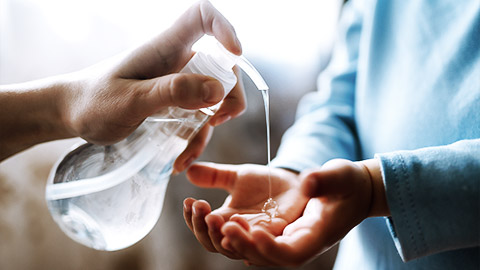
Note
The relevant Standard for dealing with health-related matters in food business is:
Managing illness is an important part of all of our lives, but again, is particularly critical when working in a food handling role.
Workers in food handling roles who head into work when they are ill can contaminate food and leave the business susceptible to food-borne illnesses. Even if the worker is not directly handling food themselves, if they are ill, they could infect another worker who may contaminate the food in their duties.
As an introduction to food hygiene and safety, watch the following Bacteria Bites Business 8-minute video (originally created by Food Standard Agency) which demonstrates the importance of good food hygiene, focusing on the 4 Cs (Cleaning, Cooking, Chilling and Cross-contamination):
How does infection spread?
- Airborne
- Transfer of bacteria or viruses via mucus or saliva, through the air, or via coughing, sneezing or nose blowing
- Airborne transmission
- Germs are spread by breathing contaminated air
- Direct contact
- Organisms transferred from one person to another
- Animals
- Infections from animal feces spread into the environment and may be passed via direct contact
- Food
- Germs can spread when people eat food that has not been jeated or chilled properly, and where good hygiene is not practised.
Infectious diseases commonly spread through the direct transfer of bacteria, viruses or other germs from one person to another. This can happen when an individual with the bacterium or virus touches, kisses, or coughs or sneezes on someone who isn't infected. 8
Globally, a food-borne illness is a common problem and the impact can range from minor to severe. It is not only illness that can cause food-borne illness, but also sub-standard food handling and storage.
Over 200 diseases are caused by eating food contaminated with bacteria, viruses, parasites or chemical substances such as heavy metals. This growing public health problem causes considerable socioeconomic impact though strains on healthcare systems lost productivity, and harming tourism and trade. These diseases contribute significantly to the global burden of disease and mortality. 9
Similarly, if you are injured, you should ensure that any wound is treated appropriately and that its treatment is compliant with workplace procedures. For example, when wearing bandages and dressings you may be required to wear particular workplace-compliant bandages which are brightly coloured for easy identification. This is to ensure the bandage can be easily spotted if it happens to come off. Chefs are encouraged to wear waterproof blue band-aids.
Adhesive dressings and other bandages or dressings: These items can easily fall into food if they are on exposed parts of the body and are not kept secure. Paragraph 15(1)(d) requires bandages and dressings that are used on exposed parts of the body to be waterproof. If the bandage or dressing is on the hand, this can be easily achieved by covering the hand with a glove. 10
How do educators help children to develop good hygiene habits?11
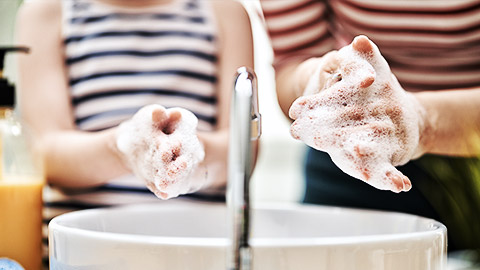
Along with other hygiene methods, educators help reduce the spread of infection by encouraging and modelling to children good hygiene habits. Children’s self-help and self-care skills can also be promoted by educators supporting them to develop hygienic habits. Educators will reinforce hygiene habits at the service through the children’s program of play experiences as well as through the daily routines such as mealtimes, nappy changing and toileting.
By setting hygiene rules with children and providing positive feedback and support, educators will help develop personal hygiene skills.
What can you do to support hygiene?
You can greatly assist your child care service by following simple hygienic procedures when you visit the service and by using good hygiene at home with children. It’s also important to be aware of and follow your service’s policy on illness and exclusion periods for infectious diseases. Exclusion periods ensure that the spread of infection is limited. Ask your educator for a copy if you’re unsure.
StartingBlocks.gov.au has a resource on teaching your child hygiene at home that might help.
What hygiene methods are used at early learning services?
Services use a range of hygiene methods to minimise cross-infection. These include procedures and specific practices that are carried out by educators and children on a daily basis. Written hygiene policies and procedures, based on recommendations from recognised authorities such as the National Health and Medical Research Council (NHMRC), state and territory health departments and Food Standards Australia New Zealand, will be in place to guide educators' practice.
Hygiene strategies that services use include:
- Supporting adults to use thorough handwashing and drying practices
- Encouraging children to follow appropriate handwashing practices
- Ensuring equipment and toys are regularly cleaned/washed and are well maintained
- Keeping facilities such as bathrooms, kitchens, sleep and rest areas, and play areas clean
- Using appropriate toileting and nappy change methods
- Using appropriate procedures for wiping children’s noses, and for teaching children how to do it for themselves
- Displaying signs and posters about hygiene procedures at child height in bathrooms and play areas
- Implementing appropriate food handling, preparation and storage practices
- Providing written information to families about the recommended immunisation schedule for children
- Developing clear procedures for handling and disposing of bodily fluids such as blood and any contaminated items used in first aid
- Providing written information to families on exclusion periods of illness and infectious diseases.
One of the most important good hygiene habits that children need to learn is hand washing, which reduces the risk of them getting ill. But there are other self-help and self-care skills too, like regularly showering or brushing teeth, that can also limit cross-infection.
When to avoid working with food
Remember that certain illnesses and injuries prevent educators in early childhood and any other food handlers from working with food. This is because harmful pathogens can be transferred onto the food you’re working with and cause a food-borne illness outbreak. Even if you don’t work with food directly, you might contaminate equipment, surfaces and other Food Handlers.
If you’re suffering from any of the following illnesses, stop working immediately and let your manager know!
Food-borne illness
This illness is caused by consuming contaminated foods or beverages — which is what you want to prevent from happening to your customers! Even if you’re only feeling mild symptoms, you can easily contaminate food and cause a food-borne illness outbreak in your business.
Symptoms of food-borne illness include diarrhoea, nausea, vomiting, headaches, stomach cramps, fever, gas, bloating and belching.
Gastroenteritis
Also commonly referred to as the “stomach flu,” gastroenteritis is the inflammation of the stomach and intestinal lining. It’s not always caused by food-related illness and many types of bacteria, viruses and parasites can be the culprit behind gastroenteritis. Some of the most common causes of gastroenteritis are norovirus, Campylobacter, E. coli and Salmonella.
Symptoms of gastroenteritis include diarrhoea, vomiting and stomach cramps.
Colds & flu
Don’t handle food if you’re suffering from a fever, sore throat, cough, runny nose or other cold and flu symptoms. If you have mild symptoms, you may still be able to perform other tasks that don’t involve working with food, though it’s important that you never come in to work with a communicable disease if you serve vulnerable persons such as the elderly, children under five years old, pregnant women and immunocompromised people.
Hepatitis A
This highly contagious liver infection is spread from person to person after putting something in the mouth that is contaminated with faeces containing the hepatitis A virus. In a food business, it can be easily spread when food handlers don’t wash their hands properly before handling foods and drinks.
A person can be contagious one to two weeks before symptoms even start, and these symptoms can last for one to two weeks. Symptoms include nausea, fever, stomach pain, dark-coloured urine and jaundice. Due to its highly contagious nature, Food Handlers should be excused from working for at least two weeks after the onset of clinical symptoms.
Other diseases

If you’ve been diagnosed with the following, you should also avoid working with food:
- Typhoid: a bacterial infection often passed through contaminated food and water that can lead to high fever, diarrhoea, vomiting and even death
- Tuberculosis: an infectious disease that affects the lungs and spreads from person to person through tiny droplets in the air from coughing and sneezing
- Cholera: an acute diarrhoeal illness caused by an intestinal infection by the Vibrio cholerea bacteria that is spread through consumption of contaminated food or water
Asymptomatic carriers
An asymptomatic carrier is a person who is carrying a virus while not showing or feeling any symptoms. While you may not show any symptoms, you can still pass the disease on to other people and cause a food-borne illness outbreak.
If you’ve been in contact with anyone who has a contagious illness, notify your manager and contact your doctor to determine next steps.
Working with an injury
Having an injury doesn’t always mean that you have to miss work, though it’s crucial that you don’t let any cuts, sores or boils come into contact with food while working.
To help prevent food contamination while working with an injury, always:
- Use clean, good quality bandages and dressings (bright-coloured bandages and dressings are helpful as they can be easily seen if they accidentally fall into food or get lost)
- Replace bandages and dressings frequently
- Wear waterproof disposable gloves over bandaged cuts and sores
Sometimes, accidents can happen in the workplace — especially if you’re working with knives and other sharp utensils or equipment.
Take the following steps if you cut yourself at work:
- Stop working right away
- Get the wound treated or seek further medical attention
- Throw away any food you were working with or may have contaminated
- Clean and sanitise all surfaces and equipment you’ve touched
- Let your manager know so that any other corrective actions can be implemented if required
Still unsure about whether to go to work when sick or injured?
Use the Australian Institute of Food Safety’s (AIFS) Employee Illness/Injury Decision Chart to help determine if it’s safe for you to work with food, and what steps you need to take when experiencing illness symptoms.
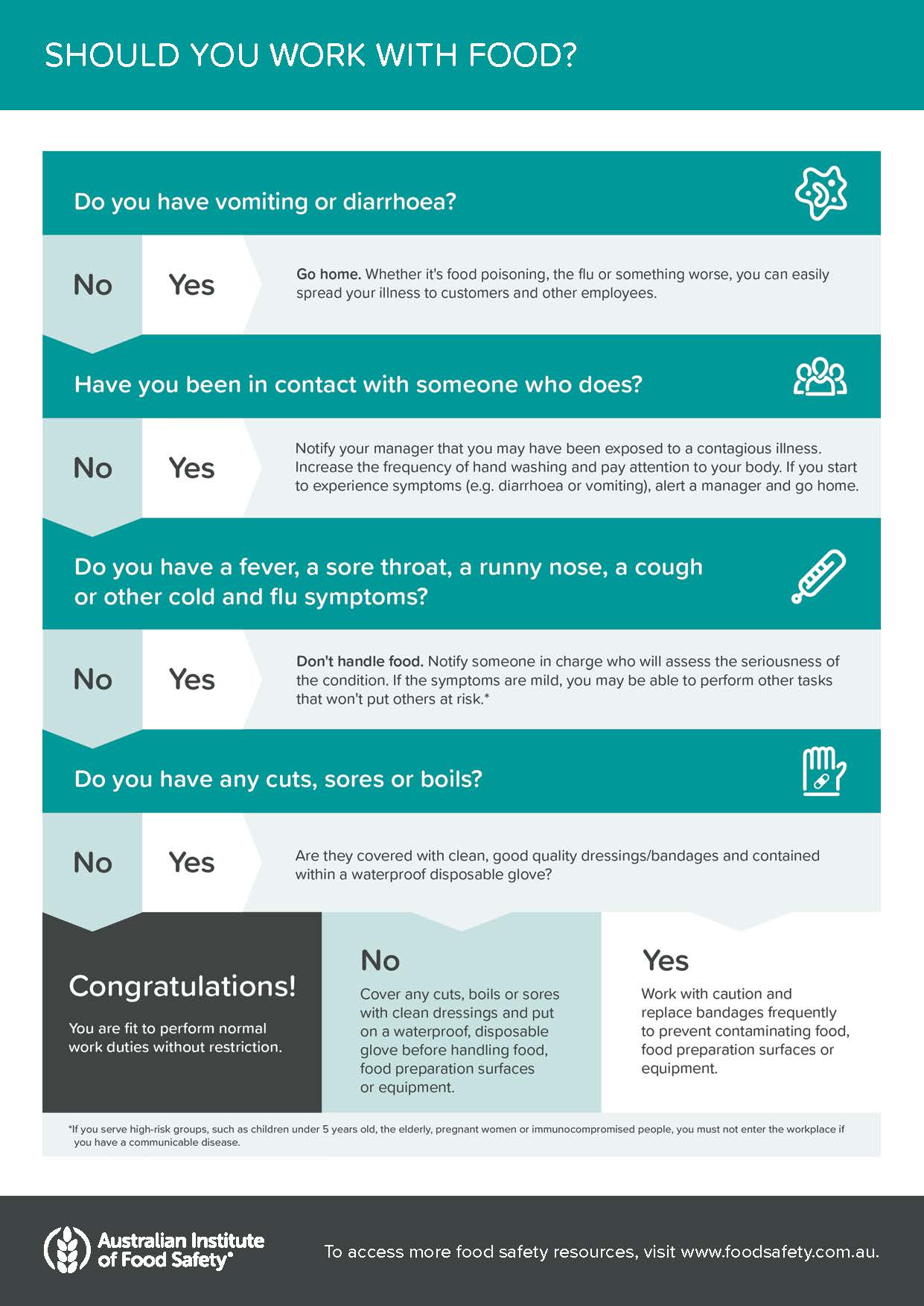
If you have any symptoms of illness or injury, it is important that you assess whether or not you are fit for work, and report your symptoms to your manager. The early childhood service will have procedures that make it clear whether you can continue with any food handling or not. This advice depends on your illness or injury (for example, a headache or injured knee may be manageable when working with food, whereas having the flu or an open wound would be unacceptable).
What to do if an employee calls in sick?
Food business owners, managers and supervisors should actively foster a positive working environment where employees feel comfortable notifying the management team about illnesses and injuries that could prevent them from working.
If a team member has notified you of a condition that may cause food-borne illness in others, or if you suspect that a staff member may be sick and should not be working with food, take the following steps:
- Determine how serious the condition is.
- Restrict the employee from working with food. If symptoms pose a serious threat to food safety, such as diarrhoea, stomach cramps, vomiting and jaundice, the employee should not be allowed on the food premises.
- Manage possible contamination by discarding any food that the employee may have met while sick and do not serve any food that may have been handled by the employee. Thoroughly clean and sanitise all surfaces, equipment and utensils they may have used.
- Work with medical specialists and the local authorities to minimise the risk of a food-borne illness outbreak. Employees with hepatitis A, jaundice or a food-borne illness should be reported to your local authorities so that they can implement the appropriate public health measures. If an employee’s illness poses a serious threat to food safety, or if you serve high-risk customer groups, work with the local authorities and the employee’s medical practitioner to determine when the employee is safe to return to work.
Services must make sure that staff suffering from a foodborne illness, such as gastroenteritis, also known as ‘gastro’, must not prepare food to avoid contamination and potential outbreaks. Educators and other staff who have a food handling role should always be excluded until there has not been a loose bowel motion for 48 hours.
Remember that certain steps need to be taken when someone in your food business may have been exposed to COVID-19. Learn how to deal with sick employees during the COVID-19 pandemic. Food business owners, managers, supervisors and Food Handlers have legal responsibilities to ensure food is prepared safely. Keep in mind that avoiding handling food when sick is just one factor in practising good personal hygiene!
Learn more about how to ensure a safe and hygienic working environment using the AIFS Guide to Hygiene and Behaviour in the Workplace (scroll down to read it without registering for an account), and ensure everyone who handles food in your business has the comprehensive food safety training they need to help prevent food-borne illness outbreaks by taking our nationally recognised Food Safety Courses.

Case Study
Consider the case study below and answer the following questions: Amy is a Chef at Little.ly Early Learning Centre. She has been feeling unwell over the weekend and has symptoms of a cold including a runny nose and cough. Amy is rostered to work on Monday and has no sick leave available to use. Amy decides she will wait until Monday morning to see if her symptoms have subsided. Monday morning comes and Amy is feeling worse. She now has a headache, and her cough has worsened. Amy decided she will attend work anyway because she does not want to let down her boss, and she needs the money. When Amy gets to work, a colleague asks her how she is feeling and she tells them that she feels unwell, but will see how she fairs throughout the day. During her food preparation duties, Amy needs to stop multiple times to cough or wipe her nose. Amy makes sure she changes her gloves each time she does this.Amy’s boss sees Amy and directs her to take sick leave for the afternoon, and not to return to work until she feels better, and her symptoms have cleared. Amy feels that this is unfair as she will not get paid for this time off.
Try to answer the following questions related to the above case study:
The following table published by the National Health and Medical Research Council (NHMRC) captures some examples of the exclusion period for most common diseases:
| Condition | Exclusion of case | Exclusion of contacts |
|---|---|---|
| Diarrhoea (No organism identified) |
Exclude until there has not been a loose bowel motion for 24 hours | Not excluded |
| Hand, foot and mouth disease | Exclude until all blisters have dried | Not excluded |
| Head lice (pediculosis | Not excluded if effective treatment begins before the next day at the education and care service. The child does not need to be sent home immediately if head lice are detected | Not excluded |
| Measles | Exclude for 4 days after the onset of the rash | Immunised and immune contacts are not excluded For non-immunised contacts, contact a public health unit for specialist advice. All immunocompromised children should be excluded until 14 days after the appearance of the rash in the last case |
| Viral gastroenteritis (viral diarrhoea) | Exclude until there has not been a loose bowel motion for 24 hours | Not excluded |
The full table can be accessed here.
Use the following questions to check your knowledge. You can check the correct answer by clicking on the 'Answer' button:
-
List TWO (2) reasons why wearing jewellery should be avoided in a food handling role.
Both the jewellery, and the skin under the jewellery, can be hard to cleanse properly, and they may carry bacteria which may contaminate food. -
Identify at least FOUR (4) times when it is appropriate to wash hands.
For example:- when your hands are visibly dirty
- after going to the toilet
- after helping a child go to the toilet, or changing a nappy
- after handling rubbish, household or garden chemicals, or anything that could be contaminated
- before you prepare or eat food
- after touching raw meat
- after blowing your nose or sneezing after patting an animal
- after cleaning up blood, vomit or other body fluids
- after cleaning the bathroom
- before and after you visit a sick person in hospital
- before and after touching a wound, cut or rash.
-
For how long, at a minimum, should hands be rubbed together when hand washing?
20 seconds -
How many diseases are caused by eating food that has been contaminated?
Over 200 -
Identify ONE (1) reason for wearing a waterproof bandage.
To prevent germs from an open wound from contaminating food.

